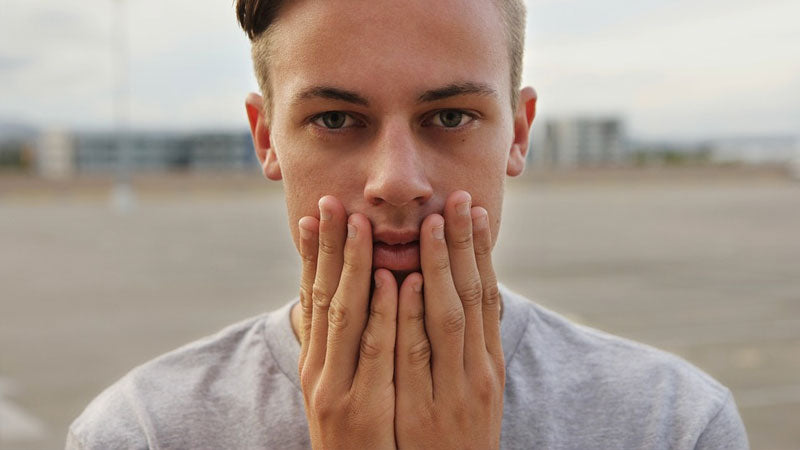Sweating is a normal body response to heat. Cold sweats, on the other hand, have the opposite purpose.
While sweat acts as a coolant, breaking into cold sweats is a physical manifestation of the body’s inbuilt fight or flight response to extreme fear or stress.
Cold sweats are characterized by a sudden sensation of a “chill”. This chill happens at the same time as the abnormal sweating. This sensation occurs irrespective of environmental temperatures at the time.
Cold sweats on their own may not pose a health risk. However, with certain symptoms, they can point to an illness that needs immediate attention.
People experiencing cold sweats report feeling cold and clammy skin. They can also look paler than usual.
Cold sweats usually appear on:
- Underarms,
- Palms, and
- Foot Soles.
Cold sweats differ from normal sweating because they are neither caused by physical exertion or rising temperatures.
They are also not the same as night sweats, which only happen during sleep.
Causes of Cold Sweats
Any condition that makes a person feel like they need to run away or fight to save themselves can cause an immediate cold sweat.
A variety of different circumstances can similarly trigger the body’s fight or flight response, such as any condition that prevents blood or oxygen from freely circulating throughout the body.
Other conditions that trigger cold sweats include:
Shock
Some conditions trigger the body into shock, including:
- Extreme environmental conditions,
- Accidents, and
- Serious injuries.
A person who is in shock needs immediate medical attention.
When in shock, vital organs including the brain do not receive enough blood or oxygen, making cold sweats inevitable.
Other symptoms related to shock include:
- Nausea
- Dilated pupils
- General malaise or exhaustion
- Dizziness
- Low blood pressure
- Very pale skin
- Breathing over 20 breaths per minute
- Raised pulse
Infection
If a person is battling an infection causing fever, they can also get cold sweats.
Cold sweats often appear when a fever seems to be “breaking” or coming down.
Very intense cases of infections may cause sepsis. Sepsis can result in both shock and cold sweats.
However, if a person has cold sweats without a preceding fever, or with the accompanying symptoms listed below, they should immediately seek medical attention.
- Disorientation
- Rapid breathing or difficulty breathing
- Loss of consciousness
- Nausea
- Vertigo
- Shivering
- Coldness
Fainting
The medical term for fainting is syncope.
Any drop in blood pressure results in an oxygen deficit to the brain, leading to loss of consciousness. A person may get cold sweats right before passing out.
Conditions that result in oxygen deficiency to the brain include:
- Dehydration
- Overheating, leading to excessive sweating
- Blood pooling in the legs
- Extreme exhaustion
- Cardiac abnormalities
Anyone experiencing fainting spells in addition to cold sweats (or without them) needs to see a doctor as soon as possible.
Alcohol or Drug Withdrawal
People attempting to stop or reduce their drug and alcohol dependence tend to deal with uncomfortable side effects. Cold sweating is one of these effects.
After getting used to certain neurochemicals, the body can trigger symptoms similar to a bad case of the flu if the drugs are withheld.
Withdrawing patients can report cold sweats as early as four hours after the last known substance use. Other symptoms may include:
- Body aches,
- Heart palpitations,
- Excessive sweating,
- Insomnia, and
- Nausea.
Intense Pain, Stress, or Anxiety
Severe injuries from bone breaks, concussions, fractures, or amputations can cause immediate cold sweats.
A patient with a broken bone likely needs immediate pain relief and medical assistance.
Cold sweats linked to anxiety happen because of the associated stress feelings of anxiety put on the body. This stress can hinder oxygen from getting to the brain and other vital organs, creating biological panic.
Panic attacks or social anxiety can trigger cold, clammy sweating and a feeling of being too overwhelmed to function.
Anxiety can additionally cause muscle tension, inexplicable pain, and vomiting.
Extreme anxiety disorders can have detrimental long-term effects on a person’s quality of life. It is always important to name and manage the triggers with professional help.
Hypoglycemia
Hypoglycemia occurs when blood sugar levels dramatically drop, triggering cold sweats.
People suffering from diabetes are more prone to hypoglycemia. The brain’s reaction to lowered sugar levels is similar to a drop in oxygen levels.
In many cases, low blood sugar can be resolved by having a fruit juice or any drink containing a small amount of natural sugar.
However, medical assistance is always advised if these symptoms occur out of the blue.
Migraines
Migraines are headaches that cause debilitating pain, usually for quite an extended time.
During a migraine, a person can get cold sweats as the body tries to mitigate the resulting pain.
Migraines can greatly affect daily life functions, but if the following symptoms appear in conjunction with a migraine and cold sweats, medical attention is paramount.
- Speech difficulties
- Blurry or lost vision
- Numbness on one side of the body
- Extreme sound and light sensitivity
- Dizziness and disorientation
Hypoxia
Hypoxia occurs when the body doesn’t supply enough oxygen to vital organs.
This could happen if a person:
- Is engulfed in a smoky environment,
- Cannot breathe in properly, or
- Is in a high altitude environment.
Cerebral hypoxia occurs when the brain specifically doesn’t receive adequate oxygen. The body usually breaks into a cold sweat, in addition to symptoms like:
- Loss of motor function,
- Sporadic body movements,
- Concentration challenges,
- Gaps in judgment, and
- Respiratory problems.
Severe hypoxia results in syncope or worse, a coma.
Emergency medical help is advised right away for anyone dealing with hypoxia that causes loss of body control or fainting.
Hyperhidrosis
Hyperhidrosis is the medical term used to describe excessive sweating.
It happens primarily as a result of exercise or intense heat. However, a person may experience cold sweats together with hyperhidrosis.
With hyperhidrosis, cold sweats usually happen without warning.
Primary hyperhidrosis affects a reasonable number of people in America. It is not a cause for concern, especially if the sweating happens without accompanying symptoms.
Research believes that it is passed down in your genes.
Secondary hyperhidrosis is more complex. It occurs in adulthood and is usually a symptom of underlying medical conditions. It can also happen as a side effect of taking medication.
If the effects of hyperhidrosis are disrupting a person’s life or if they appear out of the blue, medical consultation should be the next course of action.
Most people who have focal hyperhidrosis have been living with it for such a long time that they are unaware of the treatment options available to them.
There are many organic and cosmetic options to offer both temporary and permanent relief to people suffering from excessive sweating caused by hyperhidrosis.
Heart Attacks
One of the first signs of a heart attack is a cold sweat.
Emergency help is critical if a person gets a cold sweat followed by:
- Chest symptoms such as tightness, pressure or bloating
- Breathing trouble
- Pain in the jaw, neck, back, or stomach
- Lightheadedness
- Disorientation
- Approaching loss of consciousness
Treatment for Cold Sweats
Cold sweats are best treated by addressing the underlying cause of the symptoms outlined in this article.
Some measures to cope with a few of these symptoms include:
- Stress management strategies e.g. meditation and yoga
- Cognitive-behavioral therapy to address what triggers the fight or flight reaction
- Regular, daily physical activity
- Healthy diet choices
- Maintaining a healthy BMI
- Proper hydration
- Wearing well-aerated garments
- Keeping skin clean and dry
- Regular showers
- Hormone therapy
- Antiperspirants
It is normal to experience cold sweats at least once in your lifetime. It is part of the human survival instinct.
There are numerous causes of cold sweats that are not emergency or health-related, including hormone fluctuations or garden variety anxiety.
Anyone with chronic cold sweats should seek medical advice to rule out any potential danger to life.
Ease Your Discomfort With Sweat Proof Clothing
Sweatshield Undershirts are among the lifestyle solutions available to manage any mild to heavy cases of sweating.
We leverage years of dedicated technology to bring you 100% sweat proof undershirts, guaranteeing comfort and confidence.
If you are prone to experiencing cold sweats sweat proof clothing is an excellent option for you.
Break the vicious cycle of anxiety leading to cold sweats, leading to more anxiety about your visible sweat mark.
Sweatshield Undershirts will keep you dry so you don't have to worry about sweat marks staining your clothes or embarrassing you during your day.
Shop our line now and get relief.
Photo: Pixabay










